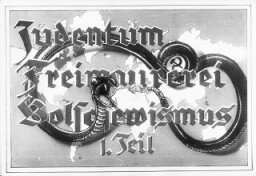You searched for: Memorial%20University%20of%20Newfoundland%EF%BF%BD%EF%BF%BD%EF%BF%BD%EF%BF%BD%EF%BF%BD%EF%BF%BD%EF%BF%BD%EF%BF%BD%EF%BF%BD%EF%BF%BD%EF%BF%BD%EF%BF%BD%EF%BF%BD%EF%BF%BD%EF%BF%BD%EF%BF%BD%EF%BF%BD%EF%BF%BD%EF%BF%BD%EF%BF%BD%EF%BF%BD%EF%BF%BD%EF%BF%BD%EF%BF%BDWeChat%EF%BF%BD%EF%BF%BD%EF%BF%BDKAA2238%EF%BF%BD%EF%BF%BD%EF%BF%BDOEA2Lj
<< Previous | Displaying results 176-200 of 338 for "Memorial%20University%20of%20Newfoundland%EF%BF%BD%EF%BF%BD%EF%BF%BD%EF%BF%BD%EF%BF%BD%EF%BF%BD%EF%BF%BD%EF%BF%BD%EF%BF%BD%EF%BF%BD%EF%BF%BD%EF%BF%BD%EF%BF%BD%EF%BF%BD%EF%BF%BD%EF%BF%BD%EF%BF%BD%EF%BF%BD%EF%BF%BD%EF%BF%BD%EF%BF%BD%EF%BF%BD%EF%BF%BD%EF%BF%BDWeChat%EF%BF%BD%EF%BF%BD%EF%BF%BDKAA2238%EF%BF%BD%EF%BF%BD%EF%BF%BDOEA2Lj" | Next >>
-
Flag graphic for US 45th Infantry Division
PhotoA digital representation of the United States 45th Infantry Division's flag. The US 45th Infantry Division (the "Thunderbird" division) was established in 1924. During World War II, they were involved in the Allied invasions of North Africa and Italy, as well as the capture of the city of Nuremberg. The division also liberated the Dachau concentration camp. The 45th Infantry Division was recognized as a liberating unit in 1985 by the United States Army Center of Military History and the United States…
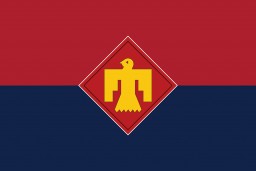
-
Flag graphic for US 4th Infantry Division
PhotoA digital representation of the United States 4th Infantry Division's flag. The US 4th Infantry Division (the "Ivy" division) was established in 1917 and fought in World War I. During World War II, they were involved in D-Day, the liberation of Paris, and the Battle of the Bulge. The division also captured the city of Nuremberg and discovered a Dachau subcamp near Haunstetten. The 4th Infantry Division was recognized as a liberating unit in 1992 by the United States Army Center of Military History and…

-
Flag graphic for US 65th Infantry Division
PhotoA digital representation of the United States 65th Infantry Division's flag. The US 65th Infantry Division (the "Battle Axe" division) was established in 1943. During World War II, they took the cities of Regensburg, Passau, and Linz. The division also overran a subcamp of the Flossenbürg concentration camp. The 65th Infantry Division was recognized as a liberating unit in 1994 by the United States Army Center of Military History and the United States Holocaust Memorial Museum (USHMM).
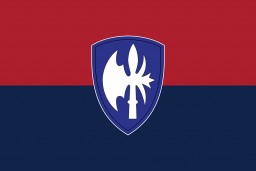
-
Flag graphic for US 69th Infantry Division
PhotoA digital representation of the United States 69th Infantry Division's flag. The US 69th Infantry Division ("Fighting 69th") was established in 1943. During World War II, they captured the city of Leipzig and uncovered Leipzig-Thekla, a subcamp of Buchenwald. The 69th Infantry Division was recognized as a liberating unit in 1993 by the United States Army Center of Military History and the United States Holocaust Memorial Museum (USHMM).

-
Flag graphic for US 71st Infantry Division
PhotoA digital representation of the United States 71st Infantry Division's flag. The US 71st Infantry Division (the "Red Circle" division) was established in 1943. During World War II, they were involved in taking the cities of Coburg, Bayreuth, and Regensburg. The division also liberated Gunskirchen, a subcamp of Mauthausen. The 71st Infantry Division was recognized as a liberating unit in 1988 by the United States Army Center of Military History and the United States Holocaust Memorial Museum (USHMM).

-
Flag graphic for US 80th Infantry Division
PhotoA digital representation of the United States 80th Infantry Division's flag. The US 80th Infantry Division (the "Blue Ridge" division) was established in 1917 and fought in World War I. During World War II, they were involved in the Battle of the Bulge. The division entered Buchenwald concentration camp and liberated Ebensee, a subcamp of Mauthausen. The 80th Infantry Division was recognized as a liberating unit in 1985 by the United States Army Center of Military History and the United States Holocaust…
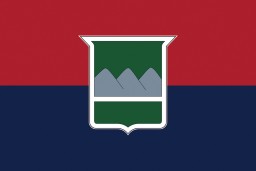
-
Flag graphic for US 82nd Airborne Division
PhotoA digital representation of the United States 82nd Airborne Division's flag. The US 82nd Airborne Division (the "All American" division) was established in 1918 and fought in World War I. During World War II, they were involved in D-Day and Battle of the Bulge. The division also overran Wöbbelin, a subcamp of Neuengamme. The 82nd Airborne Division was recognized as a liberating unit in 1991 by the United States Army Center of Military History and the United States Holocaust Memorial Museum (USHMM).
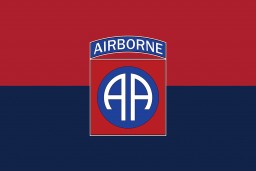
-
Flag graphic for US 83rd Infantry Division
PhotoA digital representation of the United States 83rd Infantry Division's flag. The US 83rd Infantry Division (the "Thunderbolt" division) was established in 1917 and fought in World War I. During World War II, they were involved in the Battle of the Bulge and captured the city of Halle. The division also encountered Langenstein, a subcamp of Buchenwald. The 83rd Infantry Division was recognized as a liberating unit in 1993 by the United States Army Center of Military History and the United States…
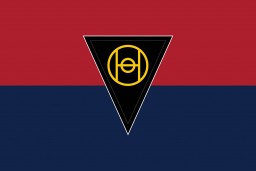
-
Flag graphic for US 84th Infantry Division
PhotoA digital representation of the United States 84th Infantry Division's flag. The US 84th Infantry Division (the "Railsplitter" division) was established in 1917. During World War II, they were involved in the Battle of the Bulge and captured the city of Hannover. The division also uncovered Hannover-Ahlem and Salzwedel, two satellite camps of the Neuengamme concentration camp. The 84th Infantry Division was recognized as a liberating unit in 1993 by the United States Army Center of Military History and…
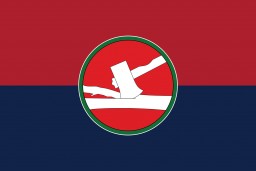
-
Flag graphic for US 86th Infantry Division
PhotoA digital representation of the United States 86th Infantry Division's flag. The US 86th Infantry Division (the "Blackhawk" division) was established in 1917 and fought in World War I. During World War II, they discovered the Attendorn civilian forced-labor camp. The 86th Infantry Division was recognized as a liberating unit in 1996 by the United States Army Center of Military History and the United States Holocaust Memorial Museum (USHMM).
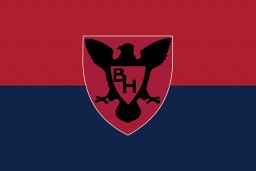
-
Flag graphic for US 89th Infantry Division
PhotoA digital representation of the United States 89th Infantry Division's flag. The US 89th Infantry Division (the "Rolling W" division) was established in 1917 and fought in World War I. During World War II, they captured the town of Eisenach and the city of Zwickau. The division overran Ohrdruf, a subcamp of Buchenwald. The 89th Infantry Division was recognized as a liberating unit in 1988 by the United States Army Center of Military History and the United States Holocaust Memorial Museum (USHMM).

-
Flag graphic for US 8th Armored Division
PhotoA digital representation of the United States 8th Armored Division's flag. The US 8th Armored Division is also known as the "Iron Snake" or "Thundering Herd" division. During World War II, they liberated Halberstadt-Zwieberge, a subcamp of Buchenwald. The 8th Armored Division was recognized as a liberating unit in 1995 by the United States Army Center of Military History and the United States Holocaust Memorial Museum (USHMM).
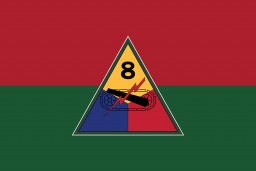
-
Flag graphic for US 8th Infantry Division
PhotoA digital representation of the United States 8th Infantry Division's flag. The US 8th Infantry Division (the "Golden Arrow" or "Pathfinder" division) was established in 1918 and fought in World War I. During World War II, they captured the cities of Rennes and Brest. The division also encountered Wöbbelin, a subcamp of Neuengamme. The 8th Infantry Division was recognized as a liberating unit in 1988 by the United States Army Center of Military History and the United States Holocaust Memorial Museum…
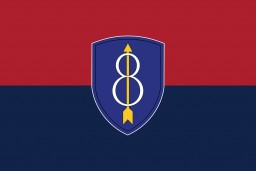
-
Flag graphic for US 90th Infantry Division
PhotoA digital representation of the United States 90th Infantry Division's flag. The US 90th Infantry Division (the "Tough Ombre" division) was established in 1917 and fought in World War I. During World War II, they were involved in D-Day and the Battle of the Bulge. The division also captured the city of Mainz and overran Flossenbürg concentration camp. The 90th Infantry Division was recognized as a liberating unit in 1985 by the United States Army Center of Military History and the United States…

-
Flag graphic for US 95th Infantry Division
PhotoA digital representation of the United States 95th Infantry Division's flag. The US 95th Infantry Division (the "Victory" Division) was established in 1942. During World War II, they captured the cities of Metz and Dortmund. The division also undercovered a German prison and civilian labor camp in Werl. The 95th Infantry Division was recognized as a liberating unit in 1995 by the United States Army Center of Military History and the United States Holocaust Memorial Museum (USHMM).

-
Flag graphic for US 99th Infantry Division
PhotoA digital representation of the United States 99th Infantry Division's flag. The US 99th Infantry Division (the "Checkerboard" or "Battle Babies" division) was established in 1942. During World War II, they were invovled in the Battle of the Bulge and liberated a Dachau subcamp near Mühldorf. The 99th Infantry Division was recognized as a liberating unit in 1992 by the United States Army Center of Military History and the United States Holocaust Memorial Museum (USHMM).
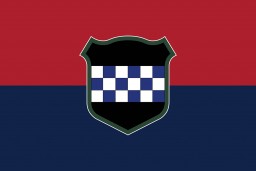
-
Flag graphic for US 9th Armored Division
PhotoA digital representation of the United States 9th Armored Division's flag. The US 9th Armored Division was known as the "Phantom" division. During World War II, they were involved in the Battle of the Bulge and also liberated Zwodau and Falkenau an der Eger, two subcamps of Flossenbürg. The 9th Armored Division was recognized as a liberating unit in 1993 by the United States Army Center of Military History and the United States Holocaust Memorial Museum (USHMM).

-
Leo Diamantstein describes Nazi marches and the Hitler Youth
Oral HistoryJoseph Leo Diamantstein was born in Heidelberg, Germany, on December 1, 1924, to Jewish parents. He was the youngest of four children. His family experienced antisemitism in Frankfurt, and ultimately decided to leave Germany. Beginning in 1933, the Hitler Youth and the League of German Girls had an important role to play in the new Nazi regime. Through these organizations, the Nazi regime planned to indoctrinate young people with Nazi ideology. This was part of the process of Nazifying German…
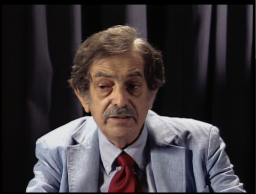
-
Beer Hall Putsch (Munich Putsch)
ArticleOn November 8–9, 1923, Hitler and the Nazi Party led an attempt to overthrow the German government. This attempted coup came to be called the Beer Hall Putsch.

-
Refugees Today
ArticleAs of mid-2022, there were about 27 million refugees. Learn more about these refugees, the violence they face, and the global impact of the refugee crisis.

-
Bernburg T4 Facility
ArticleBernburg was the fifth of six centralized killing centers established by German authorities within the context of the Nazi “euthanasia,” or T4, program.

-
Martin Niemöller: "First they came for..."
ArticleLearn about the origins and legacy of Pastor Martin Niemöller's famous postwar words, “First they came for the socialists, and I did not speak out…”
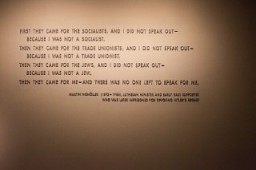
-
Blanka Rothschild describes the beginning of the German invasion of Poland when she and her family were in Lodz
Oral HistoryBlanka was an only child in a close-knit family in Lodz, Poland. Her father died in 1937. After the German invasion of Poland, Blanka and her mother remained in Lodz with Blanka's grandmother, who was unable to travel. Along with other relatives, they were forced into the Lodz ghetto in 1940. There, Blanka worked in a bakery. She and her mother later worked in a hospital in the Lodz ghetto, where they remained until late 1944 when they were deported to the Ravensbrueck camp in Germany. From Ravensbrueck,…

-
Thomas Buergenthal discusses quote from Abel Herzberg
Oral History"There were not six million Jews murdered; there was one murder, six million times."Holocaust survivor Abel Herzberg Judge Thomas Buergenthal was one of the youngest survivors of the Auschwitz and Sachsenhausen concentration camps. He immigrated to the United States at the age of 17. Judge Buergenthal devoted his life to international and human rights law. He served as chairman of the United States Holocaust Memorial Museum’s Committee on Conscience; was named the Lobingier Professor of Comparative Law…
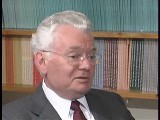
-
Freemasonry under the Nazi Regime
ArticleNazi propaganda linked Jews and Freemasons and claimed there was a “Jewish-Masonic” conspiracy. Learn more about Freemasonry under the Nazi regime.
